
Australian Black Swans (Cygnus atratus) are the most well-known and beautiful types of exotic waterfowl. These black birds have white flight feathers, a bright red bill with a pale bar and tip, and gray-black legs and feet. Cobs (male swans) are slightly larger than pens (female swans), with a longer and straighter bill. Cygnets (immature swans) are a greyish-brown with pale-edged feathers.
Black Swans mature at approximately 3 years old. Mature birds measure 43-56 inches long with a wingspan of 5-6 feet, and weigh 8-20 pounds. The neck of a Black Swan is said to be the longest neck of all the swans. The black swan’s call is a musical, bugle-like sound or a whistle, often heard while breeding and nesting.
Australian Black Swans are monogamous breeders, with both partners sharing incubation and caring for their cygnets and will aggressively defend their nest. Black Swans nest on a large heap or mound of reeds, grasses and weeds. A typical clutch contains 4-8 greenish-white eggs and incubation takes about 35-40 days. Cygnets are cared for by the parents for about 9 months.
Black swans were first discovered by Europeans in 1697, while exploring in western Australia. Today the Australian Black Swan is popular bird in zoological gardens and bird collections around the globe. The Black Swan is a regional symbol in Australia is protected in all states and territories in Australia.
The Black Swan is almost completely herbivorous, and its diet is generally consists of algae, weeds, and marshland plants. Swans can be fed a supplement of poultry layer feed of pellets or crumbles, and some scratch.
Sold as male/female pairs. Juvenile swans have been pinioned.
Swans are shipped air cargo and must be picked up at an airport serviced by Delta airlines.